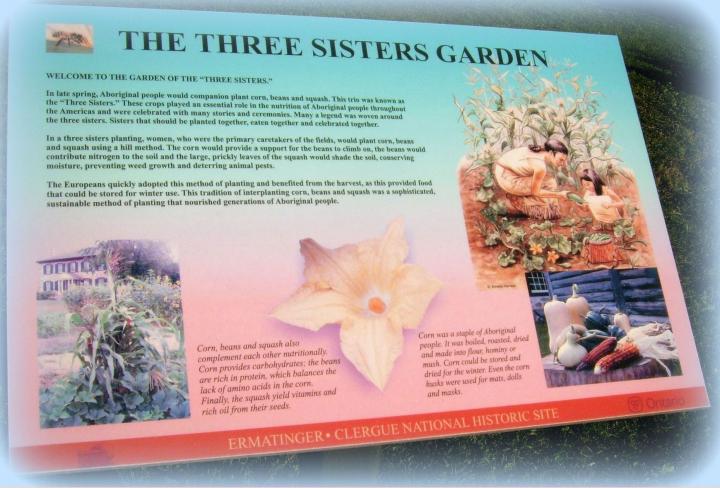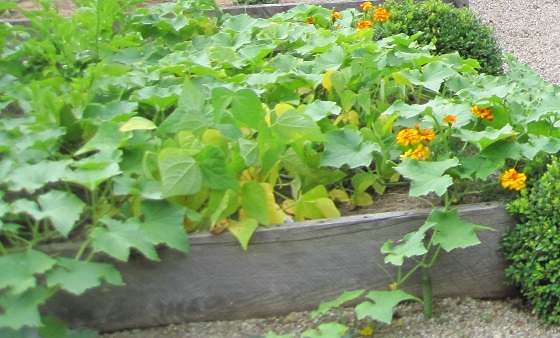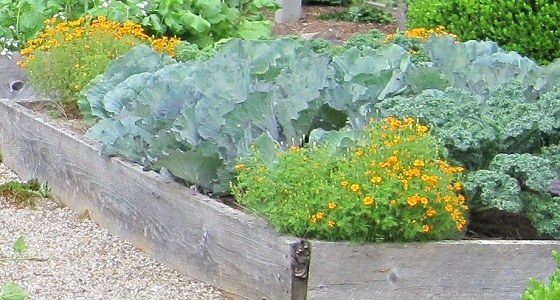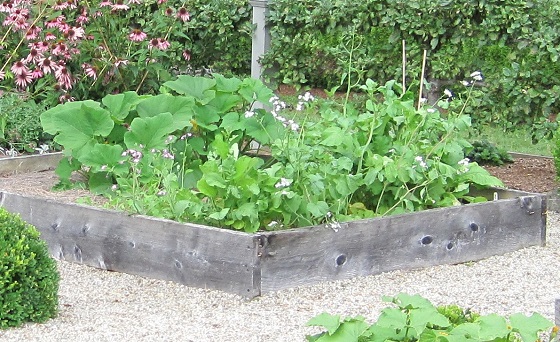 Photo from Fungus Guy: Wikimedia Commons
Photo from Fungus Guy: Wikimedia Commons
The age-old practice of companion planting is based on the theory that certain plants can either enhance, or in some cases inhibit, the growth of others.
Scientists have tested some of this folk wisdom and have found this type of interplanting to be beneficial in several ways. Some plants repel or at least confuse insects pests while others attract beneficial insects that aid pollination or attack the bad bugs. Some plants supply additional nutrients to the soil that affect the growth and flavor of their companion or simply provide them with shade.
Three Sisters Planting: Squash, Corn, and Beans
Native Americans have long used the method of companion planting called the Three Sisters which groups pole beans, corn, and pumpkins or squash. The pole beans replace the nitrogen the corn consumes while using the cornstalks for support. The corn shades the squash or pumpkins whose prickly vines smother weeds and deter animal predators from feasting on the corn and beans. Here are some other companions at work:
Garden Plants: Good Neighbors and Bad
- Basil is said to enhance the flavor of tomatoes while repelling insects and disease. It is also good to plant with peppers, oregano, and asparagus but keep it away from sage.
- Beans & peas will enhance the growth of many plants including brassicas, carrots, corn, cukes, eggplant, lettuce, radishes, and strawberries. Summer savory supposedly repels bean beetles and improves the growth and flavor of beans. Growing onions with beans or peas is a bad combination though since they will stunt each others growth.

- Beets grow well with bush beans, brassicas, lettuce, and onions. Garlic improves the flavor and growth of beets.
- Borage is a storehouse of minerals and its flowers attract beneficial pollinators and parasitic wasps. It is said to increase the pest and disease resistance of any plant growing next to it.
- Brassicas grow best when planted with bush beans, beets, dill, onions, potatoes, marigolds, and nasturtiums but do not like growing near strawberries, tomatoes, peppers, or eggplant.

- Carrots are good neighbors when planted near beans, letuce, onions, and peas. Tomatoes can stunt their growth and they don’t like growing near potatoes, brassicas, or dill.
- Cucumbers grow well with beans, peas, corn, lettuce, onions, marigolds, sunflowers, and nasturtiums, but they should not be grown near potatoes. Planting radishes in each cucumber hill is said to repel or at least confuse cucumber beetles and they are also good for repelling flea beetles. Let the radishes flower to attract beneficial insects.

- Fennel exudes a substance that is capable of inhibiting the growth of nearby plants. Only dill can stand up to it.
- Lettuce grows well with beans, beets, carrots, cukes, onions, strawberries, and radishes. Do not grow lettuce with brassicas or parsley. If slugs are eating your lettuce try planting mint to repel them.
- Lovage is reputed to enhance the growth and flavor of whatever is planted near it.
- Onions and other alliums like chives, garlic, leeks, and shallots protect a wide range of plants including roses but do not plant them near beans, peas, or asparagus.
- Parsley is a good companion for tomatoes, asparagus, roses, and carrots.
- Peppers, both hot and sweet, like to be grown with basil and onions.
- Tomato growth can be enhanced if grown with onions, basil, parsley, marigolds, and nasturtiums. If planted with brassicas neither plant will do well. Do not plant tomatoes with potatoes since both are susceptible to late blight.
Bear in mind that to have a real effect companion plants need to be grown in sufficient quantity. One summer savory plant at each end of a row of beans isn’t going to be as effective as interspersing them throughout the row and along each side.
Don’t be afraid to experiment with companion planting and let us know what works for you!
~ By
Robin Sweetser
About This Blog
Get inspired by Robin Sweetser's backyard gardening tips. Robin has been a contributor to The Old Farmer's Almanac and the All-Seasons Garden Guide for many years. She and her partner Tom have a small greenhouse business and also sell plants, cut flowers, and vegetables at their local Farmer's Market.
Related Articles
- Vegetables
- Gardening
- Companion Planting






 Photo from Fungus Guy: Wikimedia Commons
Photo from Fungus Guy: Wikimedia Commons


